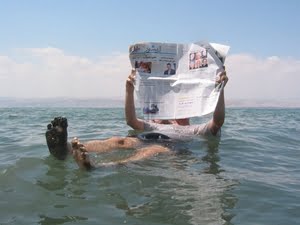While surfing the internet today, I came across a website announcing the ‘living’ Dead Sea. If the sea is called dead, how is it living? It’s called the Dead Sea because nothing lives in it. It’s said that the Dead Sea (“Yam Hamelakh — “The Salt Sea”) is the only place on the globe where the crust of planet Earth recedes to an “in-depth low. The Sea is roughly 1,300-1,400 feet (416-430 meters) below sea level. Scientists figure that the Dead Sea lowers by as much as 13 inches per year. This unique sea is fed by the Jordan River, located between Israel and the West Bank to the west, and Jordan to the east. There is no outflow, and the exceptionally high rate of evaporation (high temperatures, low humidity) produces large quantities of raw chemicals. These are extracted and exported throughout the world for use in medicine, agriculture and industry.
The concentration of minerals encourages extraction of mud and minerals for use in the cosmetics, skin care, and spa industries. The exact composition of the Dead Sea water varies mainly with season, depth and temperature. In the early 1980s the concentration of ionic species (in g/kg) of Dead Sea surface water was Cl− (181.4), Br− (4.2), SO42− (0.4), HCO3− (0.2), Ca2+ (14.1), Na+ (32.5), K+ (6.2) and Mg2+ (35.2). The total salinity was 276 g/kg. These results show that w/w% composition of the salt, as anhydrous chlorides, was calcium chloride (CaCl2) 14.4%, potassium chloride (KCl) 4.4%, magnesium chloride (MgCl2) 50.8% and sodium chloride (common salt, NaCl) 30.4%. In comparison, the salt in the water of most oceans and seas is approximately 97% sodium chloride. The concentration of sulfate ions (SO42−) is very low, and the concentration of bromide ions (Br−) is the highest of all waters on Earth. The salt concentration of the Dead Sea fluctuates around 31.5%. This is unusually high and results in a nominal density of 1.24 kg/L.
The Dead Sea is noted as a un-drown able lake on earth. Visitors can float effortlessly on the waters of the Dead Sea due to its concentration of minerals, which is the highest in the world. Floating is a novelty that makes visiting the Dead Sea a unique experience.
How does the Dead Sea compare to the Great Salt Lake in Utah? According to the Utah Water Science Center, like the Dead Sea, the Great Salt Lake has no outlet. The Great Salt Lake is a remnant of Lake Bonneville, a prehistoric freshwater lake that was 10 times larger. It is the largest lake between the Great Lakes and the Pacific Ocean, and is the largest saltwater lake in the Western Hemisphere. Not as deep as the Dead Sea, the Great Salt Lake has a maximum depth of about 35 feet. It is three-five times saltier than ocean water. The salts of the lake are primarily sodium chloride (common salt), although small amounts of other elements and salts are also present, including magnesium, potassium, sulfate, and carbonate. There are about 4.5 to 4.9 billion tons of salt in the lake, and about 2.2 million tons of salt enter the lake annually from surface and ground-water flow. Resembling the Dead Sea, The Great Salt Lake gets water from the Jordan River (Utah) as well as the Weber, and Bear rivers. Similar to the Dead Sea, the water of the Great Lake is so buoyant that people can easily float. Unlike the Dead Sea, brine shrimp are a most visible inhabitants of Great Salt Lake because of the salt. They are very important to the ecology of the lake, serving as a major source of food for migratory birds.
I.
Steinhorn, In Situ Salt Precipitation at the Dead Sea, Limnol. Oceanogr. 28(3),1983, 580-583
II.
http://ut.water.usgs.gov/greatsaltlake/index.html

